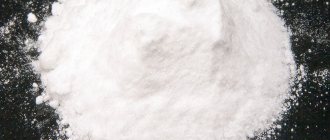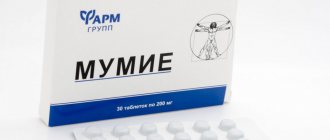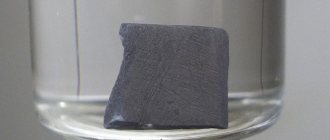Chloroform is a chemical compound that is a colorless liquid that contains chlorine. The substance was first obtained as a rubber solvent. It is also used to produce freon, dyes, and pesticides.
Until the middle of the twentieth century, the liquid was used in surgery and pharmacology as an anesthetic and anesthetic. However, it later turned out that it is very toxic, and also has a rather strong narcotic effect. Poisoning with this drug has a detrimental effect on all organs.
Compound
What is chloroform?
Chloroform is a fatty narcotic that has a stronger effect than anesthetic ether .
Unlike ether, it causes the onset of anesthesia and relaxes skeletal muscles . However, at the same time it is characterized as a very toxic agent.
Formula and properties of the substance
Wikipedia says about Chloroform that under normal conditions this chemical compound is a mobile, volatile, transparent liquid without color and with a characteristic ethereal odor. Chloroform is non-explosive and non-flammable.
The formula of Chloroform is CHCl3. The formula was established by the French chemist Dumas.
The substance is practically insoluble in water and is miscible in all proportions with fatty essential oils, alcohols and ether. It also dissolves well a large number of organic substances (for example, lecithin, paraffin, resins, rubber) and some inorganic substances (for example, iodine, sulfur or phosphorus).
Chloroform is a rather unstable . When exposed to light and air, it is oxidized by oxygen. The products of this reaction are chlorine, hydrochloric acid and carbonic acid dichloride (phosgene), a toxic chemical that has an asphyxiating effect.
For this reason, the chloroformation procedure should be avoided with an open flame. Phosgene poisoning is a fairly common occurrence when working with chloroform, which has been stored in a warm place for a long time.
To prevent the decomposition of Chloroform, it must be stored in orange glass jars. For the same purpose, alcohol or, sometimes, methenamine .
Chloroform hazard class according to the degree of exposure to humans is II (Highly hazardous substances).
Molecule structure
The chloroform molecule consists of three chlorine atoms and one hydrogen atom, each atom bonded to a central carbon. Essentially, the trichloromethane molecule is the product of the radical replacement of hydrogen atoms with chlorine atoms in the methane molecule when exposed to certain conditions.
Moreover, all C-CL bonds are completely equivalent and highly polar. The C-H bond, against the background of other bonds that have appeared in the molecule, becomes even more polarized and becomes extremely vulnerable. Therefore, with further processing of the molecule, the C-H bond is easily broken and hydrogen is replaced by other atoms (for example, also chlorine with the formation of carbon tetrachloride).
Let's look at what chloroform looks like. The formula looks like: CHCL3. The structural formula will be as follows:
Both structures reflect the chemical essence that chloroform carries. The formula shows that the molecule is quite stable and strict conditions must be applied to enter into reactions.
pharmachologic effect
Chloroform belongs to the category of neurotropic drugs used for inhalation anesthesia . The name of the substance in Latin is Chloroformium .
The drug is characterized by the ability to have a high anesthetic and toxic effect when inhaled, causing reversible paralysis of all vital functions.
Moreover, this effect is found on all living organisms - the simplest microorganisms , bacteria , fungi , higher and lower plants, animals. Under the influence of Chloroform, their vital activity and growth are suspended, and the growth of seeds in plants stops.
It is on this that the antiseptic and antienzymatic properties of the substance are based: in particular, it helps slow down the processes of decay and alcoholic fermentation of sugar .
Name
The name of this substance has several varieties. After all, like all organic compounds, it obeys the laws of the general nomenclature of molecules, trivial names and a name based on the composition of the molecule.
Therefore, there are several possible names for chloroform:
- carbon trichloride;
- chloroform;
- trichloromethane.
Chloroform: what is it? You can understand it from the names of the compounds, or you can consider the geometric structure of the molecule.
Pharmacodynamics and pharmacokinetics
Chloroform - what is it?
The mechanism of action of Chloroform as an anesthetic is associated with a decrease in the phase transition temperature of some membrane lipids . This, in turn, helps to increase the fluidity of nerve cell membranes .
The narcotic effect of Chloroform on humans is manifested in its ability to influence nervous activity , which is accompanied by a gradual decline in consciousness, decreased sensitivity to the effects of stimuli and loss of the ability to act voluntarily.
A person becomes immersed in a state of intoxication or stupor, accompanied by illusions, unmotivated and uncoordinated movements, delirium, anxiety and - sometimes - increased convulsive activity (for example, some people experience clonic-tonic convulsions ).
The local effect of Chloroform is realized through irritation of sensitive (receptor) nerve endings and other elements of the tissue system .
gets on the skin burning and redness of the skin appear , and when protected from evaporation - signs of inflammation , which are accompanied by the formation of blisters.
on the mucous membranes , and ingestion of the substance can cause severe damage to the stomach , hematemesis (bloody vomiting) and diarrhea .
Chloroform vapors are not so irritating, but when they are inhaled, various reflexes arise, as a result of which respiratory activity , heart function , as well as the functions of other organs and organ systems .
The high toxicity of the substance provokes the following complications:
- disturbances in the frequency, rhythm and sequence of contractions of the heart muscle ;
- myocardial dystrophy;
- cirrhosis of the liver;
- liver dystrophy (atrophy).
Chloroform is one of the first substances that were proposed for use as an anesthetic during surgical interventions: it has found widespread use in surgical practice since the mid-19th century.
How does Chloroform act on humans as an inhalation anesthetic?
Inhalation anesthesia is carried out by inhaling chloroform vapor. Influencing the body, this narcotic substance causes characteristic changes in all its organs and systems .
As the body becomes saturated with Chloroform, consciousness , breathing and blood circulation begin to change depending on how deep the anesthesia .
There are 4 stages of change in total:
- I - stage of analgesia;
- II - stage of excitation;
- III - surgical stage (this stage has 4 sublevels);
- IV - stage of awakening.
At the stage of analgesia, which lasts no more than 3-4 minutes, the patient is dozing and inhibited, but at the same time he is conscious and can answer questions asked to him in monosyllables. He lacks superficial sensitivity to pain, but retains tactile and thermal sensitivity. During this period, simple operations such as opening ulcers or phlegmons and diagnostic studies can be performed.
In some cases, the initial stage of the action of Chloroform is accompanied by expedient reflex movements: patients may try to remove the mask or withdraw their hands.
the centers located in the cerebral cortex , while the subcortical centers remain in a state of excitation. The patient is unconscious, but speech and motor agitation are pronounced (he may try to get up from the table, screams).
The skin is hyperemic , the superficial vessels of the body and, in particular, the face are dilated, the temperature is increased, and the beating of the arteries is increased. The pupils are dilated, but reactive to light, and lacrimation is noted . Coughing attacks often occur , the secretion of the bronchial glands increases vomiting may begin .
At this stage, it is impossible to carry out any surgical manipulations; at the stage of excitement, the body continues to be saturated with a narcotic substance to deepen anesthesia . The duration and severity of the excitement stage are individual for each individual patient.
The consequence of the effect of Chloroform on girls/women, children and patients whose bodies are exhausted is the short duration of the excitation phase and sometimes its complete absence. And, on the contrary, arousal is more pronounced in people suffering from alcohol addiction.
With the onset of the 3rd, surgical stage, the patient calms down, his breathing evens out, and his pulse rate and blood pressure approach the original values. At this stage, after Chloroform has completely put the patient to sleep, the doctor begins the operation.
The further influence of Chloroform on the reflex centers located in the medulla oblongata provokes a decrease in reflex activity, insensitivity to the effects of irritants and the patient’s loss of muscle tone . This condition is characterized as deep anesthesia .
The awakening stage begins when the patient is no longer given anesthesia . At the same time, the level of the drug in his blood decreases, the patient again goes through all stages of anesthesia , but only in the reverse order, and awakens.
Since Chloroform is a highly toxic substance and has a pronounced inhibitory effect on the liver , central nervous , respiratory and cardiovascular systems , at present it is practically not used as an anesthetic .
If the dose of Chloroform is exceeded during anesthesia paralysis of the respiratory center may develop , resulting in primary respiratory arrest . The most dangerous consequences are observed in the heart (up to its sudden stop).
Due to the advent of new drugs and methods of general anesthesia of the body, it was decided to abandon Chloroform as an anesthetic . However, over time, it was possible to develop an anesthesia that minimizes all the harmful properties of this substance.
This method involves the use of Chloroform in compliance with a strict dosage (dosing is carried out using special anesthesia machines and calibrated Chlorotec evaporators) and in combination with a large amount of oxygen. At a concentration of 3-4 vol.%, such a mixture causes anesthesia without excitation; the optimal concentration for maintaining stage III (surgical) is 1-1.5 vol.%.
Chloroform - what is this substance and how does it affect the body
Inhalation of chloroform vapor has a detrimental effect on the nervous system . Inhaling air containing only 0.09% chloroform for a short period of time provokes dizziness, increased fatigue and headaches .
The result of constant exposure to this substance in the body is liver and kidney .
According to statistics, almost every tenth inhabitant of the planet is allergic to Chloroform. It is most often expressed in the form of a strong increase in body temperature (up to 40 degrees) and vomiting (after surgical operations in which the substance was used as an anesthetic , vomiting was observed in approximately 70-85% of patients).
Animal studies have shown that inhalation of air containing as little as 0.03% chloroform by pregnant female rats results in spontaneous abortion . The same was observed in rats that were given chloroform orally.
The next generations of experimental rats and mice, who continued to inhale air with Chloroform, gave birth to a larger number of babies with various kinds of congenital pathologies than their healthy counterparts.
The effect of the substance on human reproductive function has not been fully studied. It is only known that prolonged inhalation of its vapors (for 2-10 minutes) can cause death .
Presumably, Chloroform can cause hereditary changes in the fetus and increases the likelihood of malignant neoplasms . These properties appear only in cases where the permissible concentration of the substance in the air is exceeded.
How to make Chloroform at home
On forums there are often questions “How to put a person to sleep with Chloroform?” and “How to prepare Chloroform yourself?”
If putting a person to sleep is the task of an experienced anesthesiologist, then almost anyone can obtain the substance at home if desired.
Chloroform is a chlorinated derivative of methane. It is obtained by heating bleach with ethanol (ethyl alcohol).
Preparation from ethyl alcohol
To obtain the substance in this way, you need to take 430 g of bleach, which contains 23.4% CaO2Cl2, and mix it with 1.5 liters of water. Then add 100 g of caustic (slaked) lime and 100 cubic meters. cm alcohol 88.5%.
The resulting mixture is distilled, and lime milk (a suspension of slaked lime in lime water) and calcium chloride CaCl₂ are added to the distillate. The released chloroform is separated, shaken several times with concentrated sulfuric acid and rectified (divided into practically pure components by repeated evaporation of the liquid and condensation of vapors).
Preparation from acetone
To obtain chloroform from acetone, take 275 g of bleach, which contains 33.3% active chlorine, and grind it with 800 cubic meters. cm of water and gradually pour in a mixture of acetone and water (to prepare it, take 22 g of acetone and 70 cubic cm of water).
Preparation from potassium (K) or sodium (Na) hypochlorites
This method involves electrolysis of an aqueous solution of potassium chloride and alcohol. Instead of alcohol, acetone or aldehyde can be used.
Receiving from Whiteness
One of the easiest ways to obtain the substance is by mixing White and acetone. For 100 ml of Whiteness you should take 10 ml of acetone. This amount of ingredients allows you to get a fairly large (about 3 ml) drop of Chloroform. Probably, by distillation it is possible to obtain a slightly larger amount of the required substance.
Cleaning
Once chloroform is obtained, it needs to be purified. After all, if it is used for medical purposes, then the content of impurities in it is simply unacceptable. If the purpose of use is technical, then the content of foreign substances should be limited.
There may be various impurities that chloroform contains. What it is? What are they?
- Ethanol.
- Hydrogen chloride.
- Phosgene.
- Chlorine.
There are two main ways to purify chloroform from these impurities:
- abundant rinsing with water followed by drying (allows you to completely get rid of ethanol);
- trichloromethane is washed with a strong acid, then with a strong alkali, then with water. Subsequent processing consists of drying using a water-removing agent - calcium chloride. The substance is then distilled in a fractional column.
Indications for use Chloroform
Chloroform is used as an anesthetic for surgical interventions. In addition, the range of medicines also includes the drug “Chloroform for external use”.
Since one of the main properties of Chloroform is its ability to irritate the skin and mucous membranes, it is often used in combination with turpentine or methyl ester of salicylic acid for rubbing against neuralgia and inflammatory lesions of skeletal muscles (myositis) .
In some cases, chloroform in the form of drops (mixed with tincture of valerian root ) is prescribed for hiccups , flatulence , vomiting and pain in the epigastric region .
To reduce the sensitivity of the mucous membranes of the respiratory tract affected by toxic substances with irritating and tear action (in particular, arsenic hydrogen - one of the most powerful inorganic poisons that has a blood-destroying effect and provokes the development of malignant tumors ), chloroform is prescribed in the form of a so-called anti-smoke mixture, which contains in addition to it, it includes ethyl and ammonia alcohols , as well as anesthetic ether .
History of discovery
Since when has chloroform been known? What is it and what was it used for before? Let's try to figure it out.
The first mention of this substance dates back to 1831. It was then that trichloromethane was obtained by chemist Guthrie from Harbor. However, his goal was not this substance at all; it was a successful by-product. The chemist was looking for solvents for rubber, experimented and accidentally obtained chloroform.
In the same year and a year later, two more scientists independently obtained this substance as a result of experiments. These are Eustace Liebig (who made a huge contribution to the development of chemistry) and Eugen Suberein. Their task was to find an anesthetic, and they found it. True, they learned about this effect of chloroform and began to use it a little later, only in the 1840s.
The structural formula and interaction of atoms inside the molecule was studied and constructed by the chemist Dumas in 1834. He proposed and assigned the name to chloroform, which he gave in honor of ants. In Latin, ant is pronounced formiata, and the formic acid contained in these insects can be formed from chloroform. Based on this, its name was determined.
Contraindications
Contraindications to the use of Chloroform as an anesthetic are:
- increased individual sensitivity to it;
- pathologies of the cardiovascular system ;
- liver disease;
- kidney disease;
- asthenic syndrome.
For external use, Chloroform is contraindicated if the patient has purulent-inflammatory skin diseases . There are no contraindications for oral administration.
Side effects
Exceeding the recommended dose of Chloroform when euthanizing a patient by inhalation , and especially by inhaling concentrated vapors of this substance (when the concentration exceeds 2%), leads to weakening of cardiac activity , a sharp drop in blood pressure (up to the development of collapse ) and cardiac arrest .
Chloroform vapors have an irritating effect on the mucous membranes of the eyes , respiratory tract , and when taken orally, also on the gastric mucosa . As a result of such exposure in humans:
- mucous membranes turn red;
- burning sensation occurs ;
- abundant secretion of mucus, tears and saliva ;
- coughing attacks occur ;
- of nausea appears ;
- vomiting occurs .
Increased secretion of mucus provokes breathing difficulties , and in some cases can cause suffocation .
As a result of the secretion by the salivary glands, a person often begins to vomit . The entry of vomit into the lungs , in turn, leads to suffocation or the development of pneumonia .
Chloroform vapor also irritates sensitive nerve endings located in the mucous membrane of the respiratory tract , which has a reflex effect on the function of the respiratory and vasomotor centers , as well as on the activity of the vagus nerve center .
As a consequence, after initial excitation, a person’s breathing and heartbeat (sometimes to a complete stop).
Chloroform has the ability to penetrate intact skin , initially causing irritation. Prolonged local exposure is accompanied by severe inflammation and blistering . dermatitis or eczema may develop .
In some cases, the patient may develop an addiction to Chloroform due to ingestion of the substance or abuse of it in the form of inhalation. This type of substance abuse is called “chloroformomania.”
Instant sleeping pill
Material from Posmotre.li
| TV Tropes For English speakers and those who want to get to know the topic even more deeply, the TV Tropes project has an article Instant Sedation. You can also help our project and transfer valuable information from there to this article. |
A sleeping pill gets into the character's blood, respiratory tract or stomach - and he immediately passes out. In especially severe cases, the sleeping pill will only soon be there, and the character is already passed out. Usually accompanied by a highly unrealistic fall.
In real life, sleeping pills last from a few seconds to several hours. In any case, the victim has time to feel the sting (if there is something to feel) and an influx of drowsiness, which gives the body time to take measures to soften the fall.
Instructions for Chloroform (Method and dosage)
Externally, chloroform is used in the form of a complex chloroform liniment, which contains it in equal parts with an oil extract of black henbane leaves or datura oil. The product is applied to the painful area and gently rubbed.
The drug for oral administration in the form of Chloroform in water is prescribed to take three to five drops 3-4 times a day. The drug in the form of chloroform water containing 0.5% chloroform is taken one tablespoon. The frequency of receptions is 3-4 per day.
The highest single oral dose for adult patients is 0.5 ml, the daily dose is 1 ml.
Overdose
Chloroform has a toxic effect on metabolism and the function of internal organs . The odor threshold is 0.0003 mg per liter. A clearly noticeable specific odor is observed when the concentration of Chloroform is 0.02 mg per liter.
The narcotic concentration of the substance is 0.25-0.5 mg/l. At this concentration, Chloroform provokes a change in the rate of development of reflex muscle tension , a change in the course of metabolic processes, gastric and intestinal disorders , arrhythmia , a decrease in the amount of urine excreted by the kidneys and the appearance of sugar in the urine .
Serious poisonings with the substance most often occur in people working in the pharmaceutical industry. They are accompanied by dysfunction of the heart and respiratory center , damage to the mucous membranes ( eyes , stomach , respiratory tract ).
Milder forms of poisoning are accompanied by vomiting , increased weakness throughout the body, and dizziness. Some people may experience stomach pain and restlessness.
Laboratory tests may show changes in the cellular composition of the blood , characterized by increased or decreased levels of white blood cells .
Even low concentrations of Chloroform can cause severe poisoning with liver damage .
Treatment of poisoning with Chloroform
If symptoms of poisoning occur when chloroform is administered to a patient by inhalation, anesthesia . Further measures are aimed at facilitating the airway .
a ventilator , oxygen therapy is used to eliminate oxygen starvation (humidified oxygen is supplied for inhalation) and hyperventilation is provided .
It is recommended to inhale humidified oxygen continuously for 2-4 hours, then for 30-40 minutes at 15-minute intervals.
To ensure effective oxygen transport and eliminate the symptoms and consequences of intoxication , they also resort to infusion-transfusion therapy .
The patient is warmed up and given intravenous hydrocortisone and dexamethasone (at a dose of 1 mg per kilogram of body weight). To remove toxic products the blood hemodialysis and hemosorption . of pneumonia is also considered advisable .
To normalize heart , subcutaneous injections with caffeine (10%), camphor (20%) and cordiamine (25%) are prescribed. The volume of one injection is 1-2 ml.
If symptoms of poisoning occur as a result of oral ingestion of a substance, first aid boils down to intubation of the lungs , gastric lavage , prescribing activated charcoal and laxatives to the patient - sodium salt of sulfuric acid (sodium sulfate) and vaseline oil .
The effect of Chloroform wears off within a few days. intestinal lavage before clean rinsing water (so-called siphon enema ).
Procedures aimed at preventing kidney and liver . Experts often resort to bloodletting (150-300 ml) with further partial blood replacement.
If the patient has developed a collaptoid state (mild form of collapse ), he is indicated for intravenous administration of 0.5 ml of a 0.05% solution of Strophanthin in 10-20 ml of glucose . Metazon may be prescribed .
Therapy using sympathomimetic amines ( epinephrine , norepinephrine , ephedrine , etc.) is contraindicated. In addition, sulfonamide and chlorine-containing sleeping pills should not be prescribed.
After poisoning with the drug, consuming fatty foods and alcohol is strictly prohibited.
Chloroform price, where to buy
Many people are interested in where they can buy Chloroform and whether it is possible to buy medical Chloroform in a pharmacy. Since all sedatives used in anesthesiology are dispensed either by prescription or according to special lists for medical institutions, they are not sold in regular pharmacies.
Websites of manufacturing companies and some online pharmacies offer to order the drug.
You can buy Chloroform in Ukraine for 97-150 UAH per 1 liter. The drug from the Chinese manufacturer Ruiyuan Group Limited in St. Petersburg or Moscow is sold for an average of 3200-3550 rubles.
The product from the Australian company Dentalife sells for $60 per package. At the same time, it can be delivered to all major cities of the CIS (in particular, to Kyiv, Moscow, St. Petersburg).
Receipt
Chloroform is produced in several ways.
1. A multi-stage process of methane chlorination, which occurs by a radical mechanism under the influence of ultraviolet light and high temperature. The result is not only chloroform, but also three other products: chloromethane, dichloromethane and carbon tetrachloride. The reaction looks like this:
CH4 + CL2 = CH3CL + HCL - chloromethane and hydrogen chloride are formed
CH3CL + CL2 = CH2CL2 + HCL - dichloromethane and hydrogen chloride are formed
CH2CL2 + CL2 = CHCL3 + HCL - trichloromethane (chloroform) and hydrogen chloride are formed
CHCL3 + CL2 = CCL4 + HCL - carbon tetrachloride and hydrogen chloride are formed
In this way, trichloromethane is synthesized in industry.
2. Interaction between bleaching lime and ethyl alcohol. This is a laboratory method.
3. Preparation of chloroform by electrolysis (action of electric current) on alkali metal chlorides in an atmosphere of acetone or ethyl alcohol. Also a laboratory method for producing trichloromethane.










